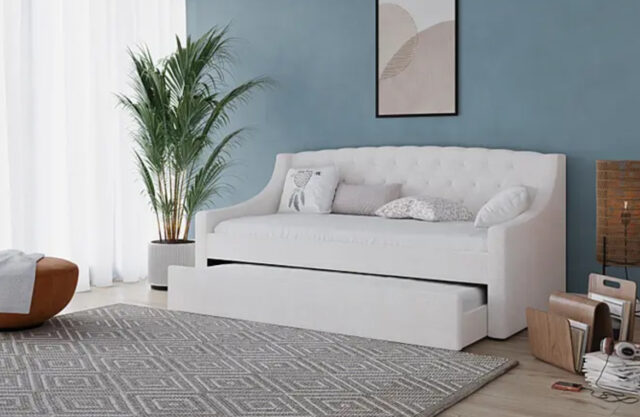Choosing a daybed that serves dual purposes for adult guest accommodation and children’s sleepovers can be a game changer for those with limited space. The key is to find a piece that offers comfort and flexibility while blending seamlessly with existing decor. To ensure that your daybed meets the dynamic demands of both uses, it’s essential to evaluate design elements and consider the durability and adaptability of the daybed’s construction.
When assessing a daybed, consider its construction and potential for multifunctional use. A versatile daybed should ideally have a strong frame to withstand regular transformation from a sitting area to a sleeping space. It’s also important to take into account the design features, like the inclusion of a trundle for additional sleeping capacity, or the presence of side rails for the safety of younger users.
Key Takeaways
- Look for a daybed that provides both comfort and flexibility.
- A strong frame and multifunctional design are critical for durability.
- Consider features like trundles and side rails for additional utility.
Determining Your Daybed Needs
Choosing the right daybed requires a clear understanding of your space limits and the daybed’s intended use. The perfect daybed can serve as a cosy spot for sitting during the day and transform into a comfortable sleeping area for guests at night.
Assessing Space and Size Requirements
When considering a daybed for a small space, measurement is essential. Assess the room’s dimensions to ascertain whether a single bed, double bed, or even a king-size bed is possible, remembering that there should be ample room to move around when the bed is not in use. If space is especially tight, daybeds with built-in storage space beneath can be ideal, serving a dual function without occupying additional floor area.
Understanding the Dual Purpose of a Daybed
A daybed is the epitome of multifunctional furniture, designed for both sitting and sleeping. For lounging during the day, consider a daybed with a high back and sides, providing a sofa-like feel. For sleepovers, ensure the mattress is supportive enough for a restful night – look into options where the daybed extends into a double bed, offering more sleeping space for adult guests or for children’s sleepovers. Prioritise daybeds that complement frequent use in both forms, maintaining comfort and durability.
Selecting the Right Daybed Features
When choosing a daybed suitable for both adults and children’s sleepovers, it’s essential to consider features that enhance comfort, suit personal style, and offer practical support and functionality.
Prioritising Comfort for Sleep and Relaxation
A daybed should serve as a comfortable bed for sleep and a cosy sofa for relaxation. Ensure that the mattress is of high quality; memory foam mattresses offer excellent support and adapt to the user’s body for optimal comfort. For a daybed used frequently, consider thicker mattresses to provide sufficient cushioning. Additionally, plush throw pillows and scatter cushions can enhance comfort whether the daybed is used as a sofa or bed.
Choosing the Appropriate Style and Design
The style of the daybed should complement the design of the guest room or the space where it will reside. Daybeds crafted from solid wood or MDF boast a sturdy and traditional appearance, while metal frames can offer a sleek, contemporary look. Consider the aesthetic appeal of the daybed, ensuring it harmonises with existing furniture and decor. An appropriate size will accommodate adults’ length and children’s activity; larger sizes like twin or full are often best.
Evaluating Mattress and Support Options
The frame’s strength is vital for durability, especially when the daybed doubles as an extra bed for visitors. A sturdy wood frame or a robust metal frame ensures the daybed can withstand regular use by both adults and children. Examine the slats or the support system under the mattress; they should be strong enough to provide even support, preventing the mattress from sagging or wearing unevenly.
Considering Additional Functionalities
Practical features like built-in drawers or a trundle bed enhance a daybed’s versatility, providing additional storage for bedding, toys, or other items, and an extra bed when needed. For tech-savvy guests or older children, look for daybeds with usb charging ports to enable easy charging of devices. Choose a versatile daybed design that is not only affordable and inexpensive but also functional for various needs, ensuring it’s a worthwhile investment.
Conclusion
Selecting the ideal daybed requires thoughtful consideration of both form and functionality. For adults, comfort and design are paramount, while durability and space optimisation matter when catering to children’s needs. Whether one is leaning towards a daybed that blends in with guest room decor or prioritises additional storage or trundle beds, the market offers a variety of choices. By evaluating these factors, one ensures a versatile and practical addition to their home, suitable for guests of all ages.




